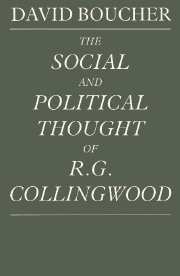Book contents
- Frontmatter
- Contents
- Preface
- 1 Collingwood in context
- 2 The New Leviathan in context
- 3 The two Leviathans and the criteria of rational action
- 4 The development of the European mind
- 5 Collingwood's liberal politics
- 6 The state and the body politic
- 7 The process of civilization
- 8 Conclusion: civilization and its enemies
- Notes
- Index
8 - Conclusion: civilization and its enemies
Published online by Cambridge University Press: 05 June 2012
- Frontmatter
- Contents
- Preface
- 1 Collingwood in context
- 2 The New Leviathan in context
- 3 The two Leviathans and the criteria of rational action
- 4 The development of the European mind
- 5 Collingwood's liberal politics
- 6 The state and the body politic
- 7 The process of civilization
- 8 Conclusion: civilization and its enemies
- Notes
- Index
Summary
Introduction
In the preceding chapter we saw that Collingwood identified civilization as the socializing process which converts the nonsocial community into the social community. To have attained the level of free will is to have attained the will to civilization. The product of the socializing, or civilizing process – that is, the asymptotic approximation to the ideal of civility – is also identified by the term civilization. Civilization contains within itself primitive survivals of the condition out of which it grew, namely, savagery. Barbarism, on the other hand, is the active attempt to retard or reverse the civilizing process. In every civilization elements of barbarity and civility coexist, and the former can never be totally eradicated by the latter, because the conversion of the nonsocial into the social community is a process which has no end, and the transeunt rule exercised by the rulers over the nonsocial community in the body politic entails an element of force which is incompatible with the ideal of civility.
In this chapter we move on from the definition of civilization to the elements of civilization that can be deduced from it. These elements are the corollaries of civilization but may not be recognised in ordinary usage. The elements, or properties, are education, wealth, law and order, and peace and plenty. Further, this chapter explores those forces at work in civilization which attempt to undermine the asymptotic approximation to the ideal of civility.
- Type
- Chapter
- Information
- The Social and Political Thought of R. G. Collingwood , pp. 221 - 243Publisher: Cambridge University PressPrint publication year: 1989



